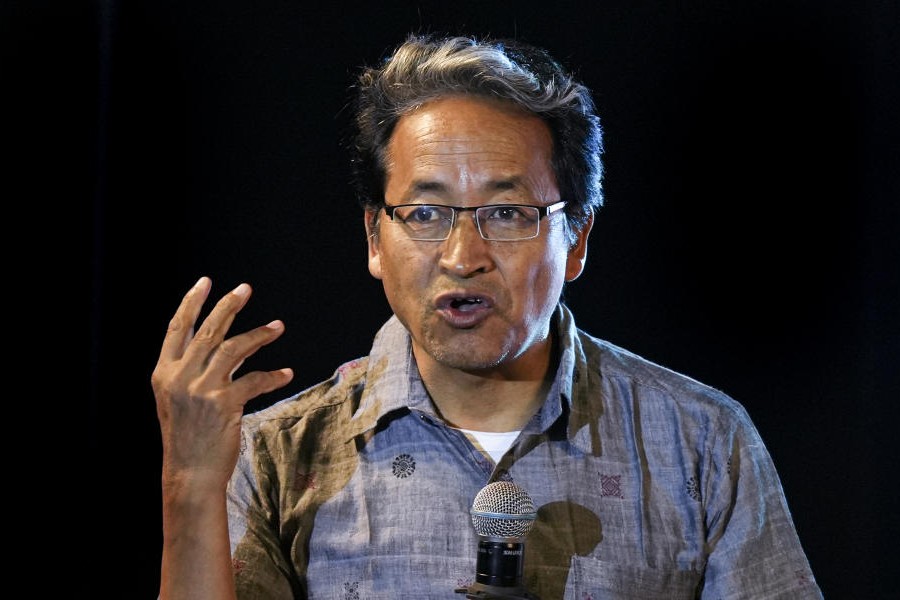 |
| Sudakshina Sarma. Above: with husband Dilip. Pictures by S.H. Patgiri |
Sudakshina Sarma
A scintillating love song played cupid for this crooner. Nahor phule nusuwai, tagor phule suwabo... rendered by young and winsome Queenie Hazarika way back in the Forties left its mark as one of the most popular Assamese love songs ever. Queenie also met her soulmate Dilip Sarma during her trip to Calcutta with Kalaguru Bishnu Rabha to record this song with the Senola company.
The couple tied the knot in 1954 and started a long innings of a musical tenure together. Today, the tall, frail lady looks as alluring as ever in spite of her wrinkled skin. Flashing a radiant smile, she says, “No, no, I was not the talk of the town. I just stood out because I was one of the few female singers at that time.”
Queenie came to be known as Sudakshina after her marriage. “My husband rechristened me Sudakshina and I have been known by this name ever since,” she says.
Singer Sudakshina Sarma, mother of three, leads a simple and austere life with her husband in a house situated atop the Sarania hills. Mellifluous strains of Jyoti and Rabindra Sangeet echoes in the nearby hills as disciples from all over Assam throng Jayjayanti Kala Kendra, their music college and art school.
The sexagenarian and her husband were jointly honoured with the 2002 Sangeet Natak Akademi Award for their contribution towards the research and practice of the state’s folk music and Jyoti Sangeet.
Sudakshina was born in 1934 at Bharalumukh in Guwahati. She was fourth of the 10 children of Nilakanta and Shantipriya Hazarika and is the younger sister of the doyen of Assamese culture, Bhupen Hazarika.
“I grew up listening to Bhupenda and used to accompany him to various functions in Dhubri, Tezpur, Sonitpur and Mangaldoi. I have memories of the cultural aura of the Ban Theatre at Tezpur,” says Sarma. “But I was always very confident and never suffered from stage fright,” she adds.
She was fortunate enough to have got a chance to interact with some of the stalwarts of Assamese culture like Rupkonwar Jyoptiprasad Agarwalla, Kalaguru Bishnu Prasad Rabha, Natyasurya Phani Sarma and others in Tezpur. “We grew up listening to the gramophone records of Pankaj Mullick, Saigal and Kanan Devi,” she says.
“In 1943, Bishnu Rabha, whom we called mama (uncle), came and stayed at our house. I rehearsed for the role of young Sankardev for a play directed by him for a half-hour programme on Assamese culture. It was to be broadcast by All India Radio (AIR). But I could not finally act in the play as I suffered from a bout of typhoid,” she says.
Queenie recalls how they used to listen to Bhupenda’s songs, which were broadcast by AIR, Calcutta. “There were only two radio sets in the locality — one at Tarun Ram Phookan’s house and one at MP Rohini Choudhury’s residence. Whenever, Bhupenda informed us, we used to rush to either of these houses to listen to his songs. But sometimes it was frustrating since we usually missed the first portions of the song while conducting the initial formalities in their household,” she says. It was then that she coaxed her father into buying a new radio for her.
She did her schooling from Panbazar Girls’ High School and got married while she was about to appear for her BA final exams from Handique Girls’ College. In her teens, Queenie once rendered a moving patriotic song before a strong crowd led by father of the nation Mahatma Gandhi at what was then known as Jubilee Park in Guwahati’s Panbazar locality. “I was very excited when Gandhiji blessed me after I sang a bhajan for him,” she says.
Being exposed to the enlightened society of those times, her life meandered through songs and culture. “Life was easy and there were no geographical or religious differences. My mother was an active member of Asom Pradeshik Mahila Samiti and used to accompany her to the various functions and meet some of the greatest women activists like Chandra Prabha Saikiani, Amal Prava Das, Md. Tayabullah and Fakruddin Ali Ahmed’s wife,” she says.
Her life got a new impetus when, in 1948, AIR opened its centre in Guwahati. “I cleared the audition and have been singing ever since. I also had the opportunity to sing at the inaugural function of the Gauhati High Court, Gauhati University and the airport at Borjhar. I even acted in plays and participated in folk dances,” she says.
She has worked as a playback singer in three LP records on dramas including Prabin Phukan’s Maniram Dewan, Sarbeswar Chakrabarty’s Piyoli Phukan besides Vishnu Shakti and Rakshya Kumar of Lakshyadhar Choudhury as well as films like Parghat, Maniram Dewan, Chikmik Bijuli and Abuj Bedana. Most of her songs are preserved in HMV, Columbia and Senola records. She also rendered the Assamese version of the Rabindra Sangeet — Arup Tomar Bani. Her other audio cassettes include Jautijugiya, Aparup Tomar Bani, Geet Gao Ekelage, Sirasundarr Sanskriti and Nijara Parar Sur.
During the Fifties, the Sarmas were attracted by the activities of the Indian People’s Theatre Association. Both represented the Assam unit of the organisation and presented Jyoti Sangeet and other numbers in China under the cultural exchange programme. The other members of the troupe were Balraj Sahni, sitar maestro Vilayat Khan, Kathak exponent Damayanti Joshi and Debabrata Biswas. “We performed at the world festival at Poland and also at an annual session of the London unit of the Asam Sahitya Sabha,” she says.
“I also rendered my voice in the first Assamese children’s film Abhuj Bedana whose music was directed by my husband and was produced by Gunasindhu Hazarika. The film was screened at international fests, too,” she says.
The couple has rendered many immortal numbers like Moyu Bane Jao Swamihe, Nahor Phule Nusuwai, Kamalkumari Mur Praneswari and Ur Ur Ur Neel Akashat. “I have sung duets with my husband for seven gramophone records,” she says.
As the state celebrates the birth centenary of Rupkonwar Jyotiprasad Agarwalla, Sudakshina recalls, “After Rupkonwar’s death, we, a group of 18 like-minded people, observed his death anniversary at the Nabin Bordoloi hall in Guwahati. I am happy that we, too, were honoured on the occasion of his centenary celebrations now.”
Steeped in nostalgia, Sudakshina smiles and clutches her walking stick, which she carries after a hip joint surgery. “Yes, I have had a fulfiling life. There is nothing more that I could ask for,” she says as the stillness of the night creeps in.











